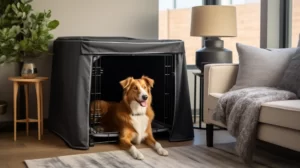A little-known fact: Sir Isaac Newton, widely recognized for his contributions to physics and mathematics, once carved a hole in his study door for his little dog, Diamond. He made a bigger hole for Diamond to pass through and a smaller one for the cat. Only if he had known about crates, he might have saved himself some carpentry!
Though crates might be a more modern invention than Newton’s time, they have quickly become an indispensable part of a dog owner’s life. They’re a convenient tool for transporting your dog, facilitating potty training, ensuring safety during injury recovery, and providing a safe, cozy den for your furry friend to retreat. However, a lingering question, often debated among pet owners and experts, is this: “Is it acceptable to crate your dog for long hours, particularly for 12 hours overnight?”
Crate training, when done responsibly, can benefit both the dog and the owner. However, it’s essential to understand the canine psychology and physiology to ensure its proper usage. So, let’s delve into the crux of the matter, and unearth what may be the best approach for you and your furry companion.
Dogs, descended from wolves, are den animals by nature. Like their ancestors, they seek the safety and solitude of a confined space. A crate can be a perfect haven for your pet, providing them with a quiet place to rest, safe from external threats and distractions. This behavior is even more pronounced in puppies who often retreat to their dens when they need respite from their intense exploratory activities. That being said, crating must not be used as a form of punishment. The crate should be a calm and positive place for your pooch where they can feel secure and comfortable.
While using a crate can be beneficial, consternation often arises around the number of hours a dog should be crated. Leaving your dog in their crate overnight might seem logical to some, but others argue it’s an unnecessarily long duration. Let’s see what the experts recommend.
Veterinarians and canine behaviorists generally agree that while it’s acceptable to crate your dogs overnight, leaving them crated for 12 hours is not advised. Adult dogs need to relieve themselves at least 3-5 times a day, irrespective of their size, breed, or health. Despite your dog’s ability to hold their bladder for several hours, it’s not comfortable or healthy for them to wait for more than 8-9 hours. Any longer could lead to urinary tract infections or other health complications, not to mention potential distress and anxiety.
Puppies require even more frequent bathroom breaks. A rule of thumb is that puppies can typically hold their bladder for their age in months plus one. This means a two-month-old puppy can only wait around three hours before needing to relieve themselves.
Moreover, dogs need regular exercise and social interaction to stay physically healthy and emotionally balanced. Therefore, interaction with their owners and the environment is crucial. Round-the-clock crating may prevent dogs from adequately fulfilling their physical and emotional needs.
A common query is whether crating your dog at night while you sleep is the same as locking them up during the working hours while you are away. No, it isn’t – because dogs are crepuscular. This means they are most active during dawn and dusk, and usually sleep during the night. That’s why they naturally tend to sleep when you do, making nighttime crating a viable option, provided it’s not overdone.
One solution for responsible crate use is to establish a set routine. Following a consistent feeding and bathroom schedule can help your dog regulate their body clock and bathroom needs. For instance, taking your dog out for a walk right before crating them for the night can help ensure they’ve emptied their bladder.
Investing time in training your dog to associate their crate as a positive and comfortable place is also imperative. Properly introducing them to the crate and slowly increasing the crating duration can make the experience less stressful. Such gradual acclimation can prevent anxiety and stress-related behavior, leading to a healthier relationship between you and your pet.
To ensure maximum comfort, choosing the right crate size is paramount. Your dog should be able to stand, turn around, and lie down comfortably in their crate. Covering the crate with a blanket, adding a comfy bed, and providing safe toys are additional ways to make your dog feel at home in their crate.
Remember, using a crate is not a one-size-fits-all solution. Everything ultimately depends on your dog’s temperament, physical stamina, age, and overall health.
The bottom line is that while crate training can be a valuable tool for dog owners, it should not be used as a substitute for proper care including physical activity, mental stimulation, and regular human interaction. Most importantly, empathy towards your canine companion’s limitations, needs, and comfort should always be your guiding principle. Your dog is a family member, not a possession to be stowed away arbitrarily for an owner’s convenience. Be discerning, be compassionate, and your furry friend will thank you with all their loyalty and love!



